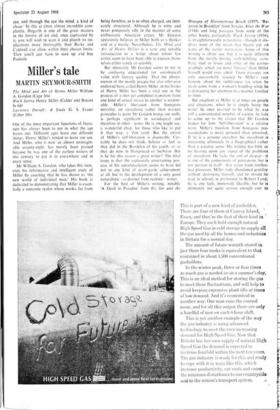Fine and handy
DAVID PIPER
Hogarth : the Complete Engravings Joseph Burke and Colin Caldwell (Thames and Hud- son 105s)
Ronald Paulson's edition of Hogarth's Graphic Works was published by the Yale University Press only three years ago. As it was of the complete engravings, fully illustrated, and a masterpiece of scholarship that must remain largely definitive for the foreseeable future, the function of this new edition by Messrs Burke and Caldwell—and they pay generous and just tribute to Paulson—might seem a bit doubtful. It has, however, a perfectly valid and honour- able place in the literature: first, it is one of a useful series, 'Masters of Graphic Art,' and, second and more important, it is only a third of the price of Paulson and it is in one volume, comfortable to handle. It will be in- valuable, for example, to those practising artists who may not be essentially concerned with detailed analysis of the subject-matter of the engravings, and is easier to use for general survey purposes. (Also, an odd point, it smells sweet and clean—one of the few possible criticisms of Paulson's edition is that it was printed in inexplicably malodorous ink.) The scholarly apparatus is kept to a mini- mum, and thus it will not serve, for example, in identifying different states of plates. Decora- tive borders and lettering in them are omitted, which is questionable, though it permits, of course, a larger reproduction of the main body of the engravings. Unlike the Paulson edition, in which the contrast-knob was turned perhaps too far towards grey, the Thames and Hudson printing is spectacularly black and white, in fact exaggerated but very striking; it has, as bonus, copious and well-chosen enlarged de- tail% as also comparative material in the form of reproductions of some related paintings and drawings. Professor Burke's introduction is admirably clear, succinct and to the point, and the brief notes are adequate, to begin with. as commentary for the general viewer.
The frequent juxtaposition on one page of close-up with long shot is an excellent entice- ment, for a generation unaccustomed to linger- ing detailed reading of engraved images of this kind, to enter into involvement with this most kinetic of 'still' artists. A series like The Rake's Progress is to a modern strip-cartoon as a symphony is to a solo on a penny whistle. The trouble is that, once as viewer you are in- volved, you will find it difficult to stop investiga- tion of the inexhaustible wealth of allusion and detail in Hogarth, and will become en- tranced by that paradoxical counterplay of brute subject-matter against its most elegant description by line—in his own words, 'a composed intricacy of form, which leads the
eye, and through the eye the mind, a kind of chase.' In this at times almost incredible com- plexity, Hogarth is one of • the great masters in the history- of art and, once captivated by it, you will wish to scan it and plumb its im- plications more thoroughly than Burke and Caldwell can allow within their chosen limits. Then you'll gist have to save up and buy Paulson.



































 Previous page
Previous page